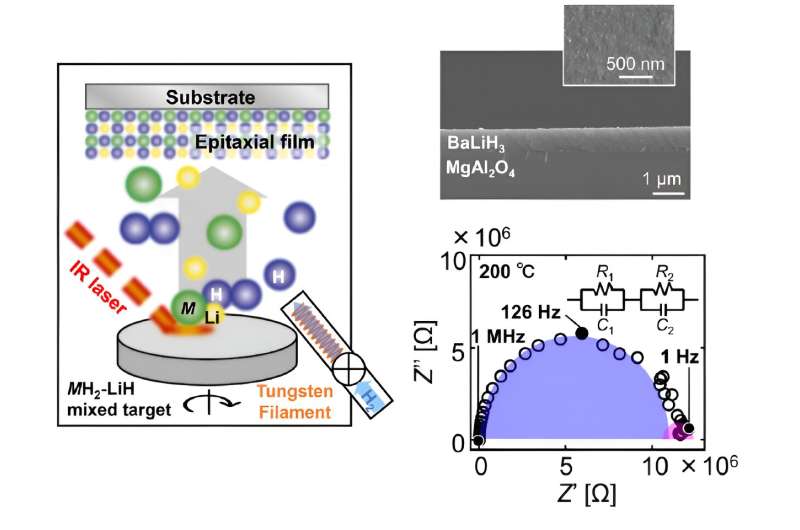This article has been reviewed according to Science X's editorial process and policies. Editors have highlighted the following attributes while ensuring the content's credibility:
fact-checked
trusted source
proofread
Shedding light on perovskite hydrides using a new deposition technique

Perovskites are currently a hot topic in materials science due to their remarkable properties and potential applications, including sustainable energy technologies, catalysis, and optoelectronics, to name a few.
Perovskite hydrides, whose molecular structure contains hydrogen anions (H−), attract special attention because of their hydrogen-derived properties. Many experts believe these compounds could be key in the study and development of hydrogen storage technologies, such as fuel cells and next-generation batteries, as well as energy-saving superconducting cables.
Even though perovskite hydrides represent a unique platform for applied materials science, characterizing their physical properties has proven challenging. In particular, measuring the H− conductivity of these crystalline materials is not straightforward. In most studies, researchers use powdered samples in their characterization analyses, meaning that H− conduction is affected by the irregularities ("grain boundaries") in the crystals.
To get true values for the intrinsic H− conductivity of a given perovskite, one needs to produce a uniform, continuous single crystal with as few imperfections as possible. For complex ternary perovskite hydrides, achieving this is difficult, and very few research groups have attempted it.
In a recent study published in ACS Applied Energy Materials on 8 April 2024, a team of researchers including Doctoral course student Erika Fukushi from the Department of Regional Environment Systems of the Graduate School of Engineering and Science at Shibaura Institute of Technology (SIT), Japan, decided to stand up to the challenge.
Using an innovative approach to produce high-quality single crystals, the team performed some of the first intrinsic conduction measurements on ternary perovskite hydrides. This work is co-authored by Fumiya Mori, Kota Munefusa, and Hiroyuki Oguchi from SIT and Takayuki Harada from the National Institute for Materials Science.
To produce the perovskite single crystals, the researchers developed and pioneered a powerful method called "H-radical reactive infrared laser deposition." This approach involves shining an infrared laser onto a rotating disk-shaped pellet containing the metal atoms of the desired perovskite.
In their study, the researchers wanted to produce MLiH3 (where M is either Sr or Ba), and thus the pellet was made of a crudely compressed mix of MH2 and LiH powders. As this pellet was heated up by the laser, the metals were released from it into a surrounding H-radical-rich atmosphere, obtained by injecting hydrogen into the reaction chamber through a heated tungsten filament.
Nearby the pellet was a carefully selected substrate, onto which the hydrogen and metals spontaneously combined to form the desired perovskite. As atoms began to pile up onto the substrate, they spontaneously arranged and aligned themselves in a consistent manner with the crystal layers below them. This led to the epitaxial growth of a nanofilm on the substrate.
"Our approach is unique in its ability to perform deposition in a radical hydrogen atmosphere, significantly promoting the reaction between the metal and hydrogen," explains Fukushi. "This results in the synthesis of single-phase hydride thin films by fully hydrogenating the metal atoms that naturally tend to persist in the film."
The researchers performed multiple laser depositions under a variety of conditions and thoroughly characterized the resulting thin films. Using many advanced techniques, including X-ray diffraction, atomic force microscopy, and scanning electron microscopy, they determined the elemental distribution and crystallinity of each of the films. In this way, they determined the optimum conditions in their experimental setup for growing well-ordered, single-crystal MLiH3.
After confirming the absence of grain boundaries in the films, the team could finally carry out H− conductivity measurements. Worth noting, these were the first measurements of the intrinsic H− conductivity of these crystals, a crucial information for selecting materials in many hydrogen-related applications.
"Novel secondary batteries and fuel cells may be developed using hydride-ion conduction," comments Fukushi. "Such technologies could encourage the spread of electric vehicles and renewable energy, ultimately contributing to the construction of an energy-saving sustainable society."
More information: Erika Fukushi et al, Epitaxial Thin Film Growth of Perovskite Hydrides MLiH3 (M : Sr, Ba) for the Study of Intrinsic Hydride-Ion Conduction, ACS Applied Energy Materials (2024). DOI: 10.1021/acsaem.3c03188
Provided by Shibaura Institute of Technology


















